
Written by: Zahrah Mazhar
Posted on: July 07, 2014 |  | 中文
| 中文
Domes of Ayasofya and Blue Mosque in view from Imperial Gate
You don’t need to look too deep into history to learn that the sultans of the Ottoman Empire had a taste for the finest things in life – from goblets made of gold to thrones adorned with jewels, the more extravagant the better. Sultan Mehmed II also belonged to the lineage of the opulent empire, which is why when he decided to build Topkapi Sarayi (Topkapi Palace), no expenses were spared and no details were left unattended.
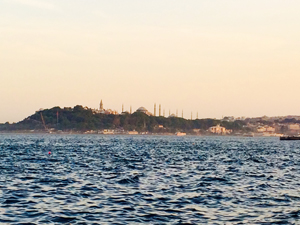 |
Seraglio Point and view of Topkapi from Karakoy |
Even the location of the royal residence is perhaps the most ideal in the city with panoramic views of the European side as well as the Asian side. The impressive structure sits atop the headland, Sarayburnu (Seraglio Point), overlooking the Sea of Marmara, Golden Horn and the Bosphorus. The construction of the palace, which was built around four courtyards leading one into the next, started after the conquest of the city in 1453. Sultan Mehmed II established the basic layout of the palace but it developed over centuries with ruling sultans adding and changing its structure. It went on to become the residence of the sultans for nearly 400 years and today, it is one of the must-see spots for people visiting Istanbul.
Located in the old city, Sultanahmet, the palace is easy to get to by public transport, but make sure not to get on any bus or tram which says ‘Topkapi’ cause it could easily take you to the Topkapi neighbourhood instead of the palace. Right beside the Ayasofya (Hagia Sophia) is the Bâb-i Hümâyûn (Imperial Gate) which leads to the outer courtyard of the palace, free to the visitors for a stroll at their leisure. The Imperial Gate is the first of the three ceremonial gates of the palace. There you’ll find one of the few surviving Byzantine churches, also said to be the first church of Constantinople, the Aya Irini Kilisesi (Hagia Eirene which means Holy Wisdom).
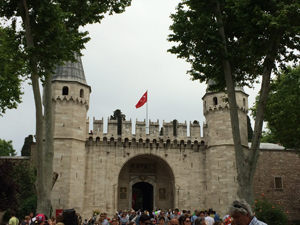 |
Gate of Salutation |
Next you’ll see the Bâb-üs Selâm (Gate of Salutation), also called the Middle Gate, which was built in 1468 and has two towers resembling entrances of European castles. Much grander than the first gate, the Gate of Salutation fits the description of an entrance to a royal palace. It is said that only the sultan could pass through the gate on a horse while everyone else had to walk. Today, it leads visitors into the Second Courtyard which has the Imperial Treasury exhibiting the arms and armour, Imperial Stables, palace kitchens, the Tower of Justice and so much more. For those exploring the palace for the first time and in one day (which may sound enough but really isn’t), the number of things to see in the palace can be overwhelming. Best is to do some research beforehand and go directly to the areas which are of interest to you. In the second courtyard, the Imperial Council (Dîvân-i Hümâyûn) is definitely worth a look. The building of the Divan is the chamber where meetings would be held between ministers of state, council ministers, the Imperial Council and other officials of the Ottoman state.
To the left is the Harem – the secluded quarters of the Sultan himself, the Queen Mother, his wives, other female family members, black eunuchs and concubines. Although there are more than 300 rooms and other wards within the Harem, your ticket (separate from the ticket for the Topkapi Museum) gives you access to only 40 rooms.
One striking feature to note is the different tiles found all over the palace which are beautiful examples of Turkish art. Take time to appreciate the palace’s varying architectural styles which reflect the glory and vibrancy of the Ottoman rulers.
The third gate, Bâbü’s-saâde (Gate of Felicity), which leads to the Third Courtyard, was used only by the sultan and an unauthorised crossing of the gate was considered as a challenge to the Sultan’s absolute power. The gate opens into the Divan Meydani square where only special events took place.
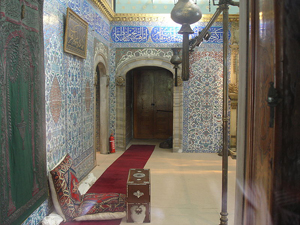 |
Inside the Chamber of the Holy Mantle |
This courtyard was and is considered the heart of the palace — during the Ottoman rule because it was the sultan’s private domain and today, because it houses the Imperial Treasury as well as the Privy Chamber – home to some of the most sacred relics of the Muslim world. Before going into the Imperial Treasury (Hazine), have a look at the Dormitory of the Expeditionary Forces next door which displays the Imperial Wardrobe Collection (Padisah Elbiseleri). It is a valuable collection of around 2,500 garments, including the beautiful 550-year-old, red and gold silk kaftan worn by Mehmet the Conqueror.
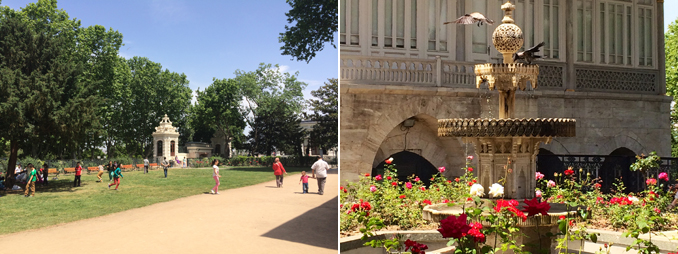 |
Fourth courtyard garden |
Sadly but understandably the use of camera inside all the treasuries is strictly forbidden, so no matter how badly you want to take a picture of the beautifully crafted sword of the sultan, keep the camera in your bag unless you’re willing to be told off by the guards! The Imperial Treasury displays a vast collection of art, jewellery and precious stones – some of whom have never left the confines of the palace - in three rooms. From the ebony throne of Sultan Murat IV to the Topkapi dagger ornamented with three large emeralds to the 86-carat Spoonmaker’s diamond set in silver and surrounded with 49 diamonds – the entire collection is a feast for the eyes. It is easy for anyone to be mesmerised by the craftsmanship and grandeur of these items, but for the fans of the popular Turkish drama, Muhtesem Yüzyil (The Magnificent Century), it was a fantasy come true. Tourists from Russia, Greece and Pakistan (where it is named Mera Sultan) flocked to the treasury and weren’t shy in asking the guards if the drama had been filmed at the Topkapi Palace.
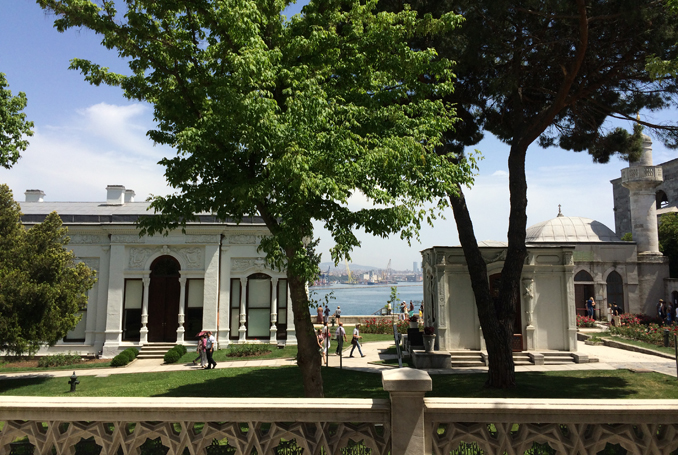 |
Mecidiye Pavilion (left) and Terrace Mosque (right) |
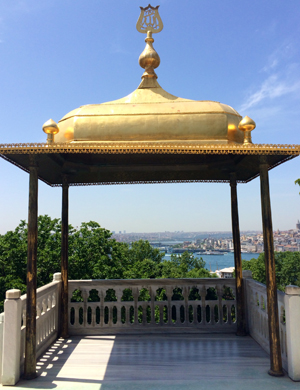 |
Iftar kiosk |
Next is the Privy Room and the Pavilion of the Holy Mantle, a place held in high-regard for its rare relics, known as the Sacred Trust, which include a tooth of the Prophet Muhammad (PBUH), hair from his beard, impression of his footsteps and the mantle itself. Some of the relics were given as gifts to the sultans, and others were taken from Cairo by Sultan Selim I in the early 16th century. While you quietly walk through the dimly-lit passages, men recite passages from the Holy Quran. Swords of the first four Caliphs of Islam, keys to the Kaaba, the rod of Hazrat Musa (Moses) and the sword of Hazrat Dawud (David) are among the other historical treasures on display. At one time these relics were displayed only to the sultan, his family and the court during a ceremony on the fifteenth of Ramadan each year. In 1962 they were put on public display and since then, the pavilion has become a place of great interest for Muslims as well as non-Muslims.
The Fourth Courtyard, also known as the Tulip Gardens, is the place to enjoy the sea breeze while looking over the Bosphorus. You can either lounge around the courtyard’s terraces or head down to the Mecidiye Pavilion - the very last building ever constructed in the palace – which is now home to the Konyali restaurant. The prices are slightly steep but, considering the large number of visitors flocking to enjoy the restaurant’s wonderful views, justified. The Circumcision Room, a summer kiosk for the circumcision of young princes, is worth a look. Thought to have been built during the reign of Sultan Süleyman the Magnificent, the room’s exterior and interior are decorated with beautiful tiles.
More intricate tiles adorn the two kiosks – the Baghdad Kiosk and the Iftar Kiosk – standing on the Marble Terrace. The Baghdad Kiosk, built to commemorate the Baghdad Campaign of Murad IV after 1638, served as a library for many years. The Iftar Kiosk, which overlooks the Golden Horn, was built under Sultan Ibrahim (1640-1648) and is known to be the place where the sultans would break their fast in Ramadan.
Finally, head down the hill to the west of the palace towards the Istanbul Archeological Museums – that is if you have time and energy left after exploring the palace. Otherwise, head to the lush Gülhane Park, the oldest park in Istanbul, separated from the palace by high walls on one side. With plenty of shade to rest under, find a spot with a view of the Bosphorus – almost as good as the view of the royals - and treat yourself to a cup of Turkish tea.
Images provided by author
Click to view picture gallery
You may also like: